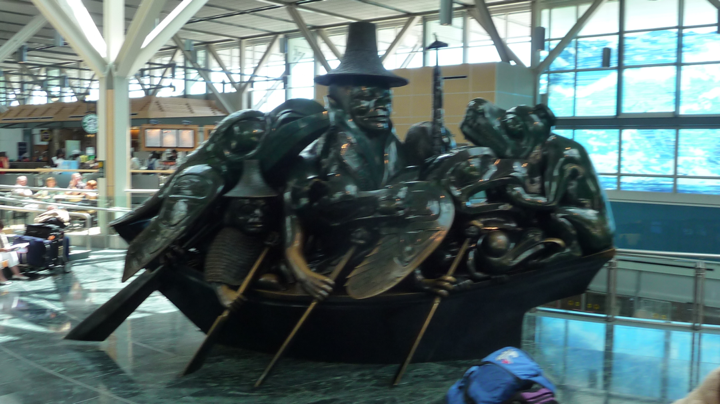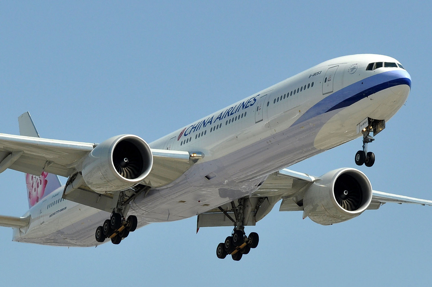Dallas / Ft. Worth - DFW
/An airport “as big as Texas.”
DFW is the third-busiest airport in the world, located in the heart of the rapidly-growing Dallas-Ft. Worth Metroplex, halfway between those cities. Corporate center for giants such as ExxonMobil, AT&T, JCPenney, EDS, and Kimberly-Clark, the area started as an important rail center, agricultural and finance hub. Strong transport links - not just road, rail, and air, but also pipeline and dataline - promoted business expansion and population growth.
American Airlines (AA) was an early pioneer, sending their first transcontinental line through here, and significantly building their operation after the collapse of rival Braniff in the early 1980s. Today, American controls about 4/5 of the airport’s gates with frequent service to all major US points and regional service extending from the Desert Southwest up into the Great Plains, Great Lakes, and the Deep South.
American is very strong in Latin America and Europe out of DFW, with a steadily growing portfolio of nonstops to Asia - in Summer 2017, Hong Kong, Shanghai, Beijing, Seoul, and Tokyo. American’s oneworld alliance partners JAL and Cathay Pacific provide plenty of onward connections throughout all of East and Southeast Asia. JAL has recently introduced a DFW - Tokyo Narita nonstop to complement AA's service. American also has codeshare connections inside China with Hainan Airlines.
The SkyTeam alliance serves DFW from Asia several times per week with a Korean Air nonstop from Seoul-Incheon, which is timed well for flights from Guangzhou and Hong Kong. While Delta is also in SkyTeam, DL and KE don’t cooperate on this route ... in fact, American and Korean Air now have a codeshare arrangement on each other’s DFW-ICN flights!
DFW has been attracting an impressive array of international carriers who may also have interesting fares and flight times to East Asia, including Emirates via Dubai, Etihad via Abu Dhabi, and Qatar via Doha. Qantas flies one of the longest nonstops in the world, from DFW to Sydney, in case you have a South Pacific stopover in mind!
Customs Arrival
All flights from Asia arrive at Terminal D. You'll exit the aircraft and follow a walkway over the gate area to passport control, then descend below the gates to the ground floor for baggage claim / inspection. (As with other US airports, be sure to notice which lines are for American citizens and use those.)
If you’re connecting to another flight, take your bags to the airline counter and then proceed through security back upstairs to the gate level. If you’re driving home or taking ground transportation, head out to the reception area on the ground level.
Total time once off the airplane, through customs and back through security into the gate area, is usually 30-45 minutes per traveler reviews (although some US citizens have said as little as 20 minutes.) DFW has recently introduced automated passport kiosks for US citizens and these have the potential to bring wait times down even further.
Navigating the Airport
DFW's terminals and gates are arranged in five separate buildings:
- Terminal A (American mainline)
- Terminal B (American regional services - small jets)
- Terminal C (American mainline)
- Terminal D (International services)
- Terminal E (Delta, United, Frontier, Spirit, a few American flights, and other domestic carriers)
The terminals are bisected by the main access highway, parking ramps, and hotels.
Terminal D was the most-recently constructed and feels like a modern, world-class facility with plenty of natural light, good sightlines, and packed with family-pleasing amenities.
Each terminal is shaped like a half-circle and takes about 5 minutes to walk from end to end. Terminals A, B, C, and E were built in the early 1970s out of poured gray concrete, and as the curve in each terminal’s hallway prevents you from seeing where you’re going, all gates tend to look alike. The halls are a bit too narrow for the traffic they get, and there are stores and restaurants squeezed into every niche, so you have to pay close attention to where you’re going - if to not get run over, then not to miss your gate.
Terminal C will be either the last to be overhauled, or else it will be torn down and replaced with a structure more like Terminal D. In either case, it looks like there will be a sixth building, Terminal F, constructed before Terminal C's final status. American has made some improvements, however, and this gate looks far more comfortable than it did in 2010...
Terminal E is undergoing renovation in 2017, and this is an example of a completed gate - a real upgrade compared to the Terminal C gates...
Reconstruction is underway on these older buildings to improve this situation, taking design cues from Terminal D. There is much more natural light and a bit more seating space in the refurbished areas, and plenty of power outlets to recharge your devices.
Above the gate level, inside the security zone, Skylink trams loop through each terminal, with tracks going in both directions. From one terminal to the next takes only about 2-3 minutes; from Terminal A to Terminal D takes about 9 minutes. You get a great view of the entire airport from the Skylink, and the stations are bright, sunny, and clean.
Bridges with moving sidewalks connect Terminals A & B; A & C; C & D; and B & D. If you’re coming in at Terminal C, it will be faster to take the bridge to Terminal D than to use the Skylink (although you can sit down on the train, and the view is wonderful...)
Family-friendly Amenities and Hidden Gems
DFW has been investing in updating the older terminals, and flyers with kids have already seen benefits. In addition, Terminal D was constructed with families’ needs in mind from the ground up.
Play areas can now be found in 4 of the 5 terminals, with 2 in Terminal D (but none in Terminal A.) The small play area near D-33 is hooked up to the McDonald’s, and the Pepsi-sponsored areas near B-12 and C-14 are aviation-themed with play planes and towers to clamber over. There are also modest play areas with kid-sized furniture at D-10 and E-23.
Specialty stores for kids include Gepetto's at A-15
Places to find quiet and open space are tricky to find at a busy airport, but DFW has made a strong effort recently to create pockets of calm throughout the complex. There are “comfort lounges” set up in several locations in each terminal, plus spaces on the gate level near most Skylink stations, which have more personal-space, are out of the flow of traffic, and often feature comfy chairs.
Samsung is sponsoring “Mobile Travel Lounges” in each terminal with subdued lighting, ample power for recharging, sophisticated decor and plush seating. (Not really the best place for kids, but heavenly for Mama or Baba to decompress in...)
The Skylink stations are an altogether different experience from the gate-level areas in Terminals A, B, C, and E - bright and uncluttered with a tremendous view. The stations are also populated with large commissioned artworks (as is Terminal D), and the terrazzo floors are great for kids to examine and create stories about.
Restrooms
DFW has an ample number of restrooms; you’re always within eyeshot of at least one set from any gate. In Terminals A, B, and C there are four dedicated family restrooms; 3 are located in Terminal E, and in Terminal D, all 10 locations have family facilities.
Family restrooms feature a large, enclosed toilet stall and have a fold-down changing station, electric sockets, and a chair. They can be locked for privacy.
Standard restrooms are well-maintained, if showing their age in the older terminals. Stalls do not have shelving and are generally not big enough to manage your bags and a child. In the men’s restrooms, there is usually a shelf over the urinals to set a bag. Both men’s and women’s restrooms include changing tables.
Food and Shopping
Overall, DFW has managed to fit in a generous selection of vendors, balancing low-cost and luxury, fast food and slow, t-shirts to Brooks Brothers, with a growing selection as remodeling is completed.
Terminal D was designed to accommodate more food and shopping like more-recent airports, and it does not fail to impress, with over 24 food outlets and 20+ storefronts in the secure zone. Terminal A’s redevelopment has also expanded food court areas, and there are over 20 places to eat in that building as well, with 19 shops. Terminal C is the next-best for choices (27 food and 16 shops), with less-used Terminal E coming in with 19 food / 11 shops. The American Eagle-dedicated Terminal B has only 13 eating choices and 7 shops - walk next door to Terminal D for better selection if you have the time.
If you have time, a unique shopping experience can be had at the far northern end of Terminal C, where you'll find the DFW Employee Store - open to the public, too - for a fun selection of airline-themed apparel, toys, and travel gear, some of which you won't find anywhere else.
Connectivity
WiFi is available for free from AT&T. There are free wired Internet and power connections near 3-4 gates in each terminal. Samsung also sponsors “mobile travel lounges” at two gates each in Terminals A, B, C, and D.
Take shuttle buses from the ground floor of each terminal to access the DART station.
The DART light rail Orange Line now connects DFW to downtown Dallas and beyond from its station next to Terminal A. Trip time is about one hour to the main station downtown.
Trinity Railway Express serves DFW at a remote station (which can be accessed by free Remote South shuttle bus). Trains travel to both downtown Ft. Worth and downtown Dallas, Monday through Saturday; there is no Sunday service.



































